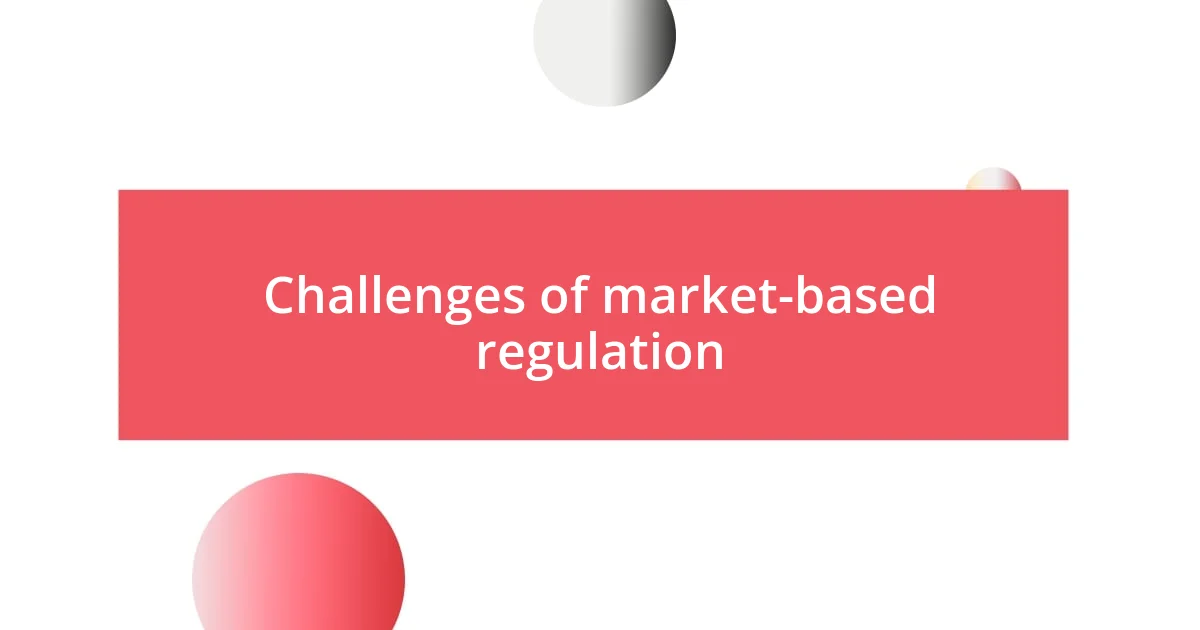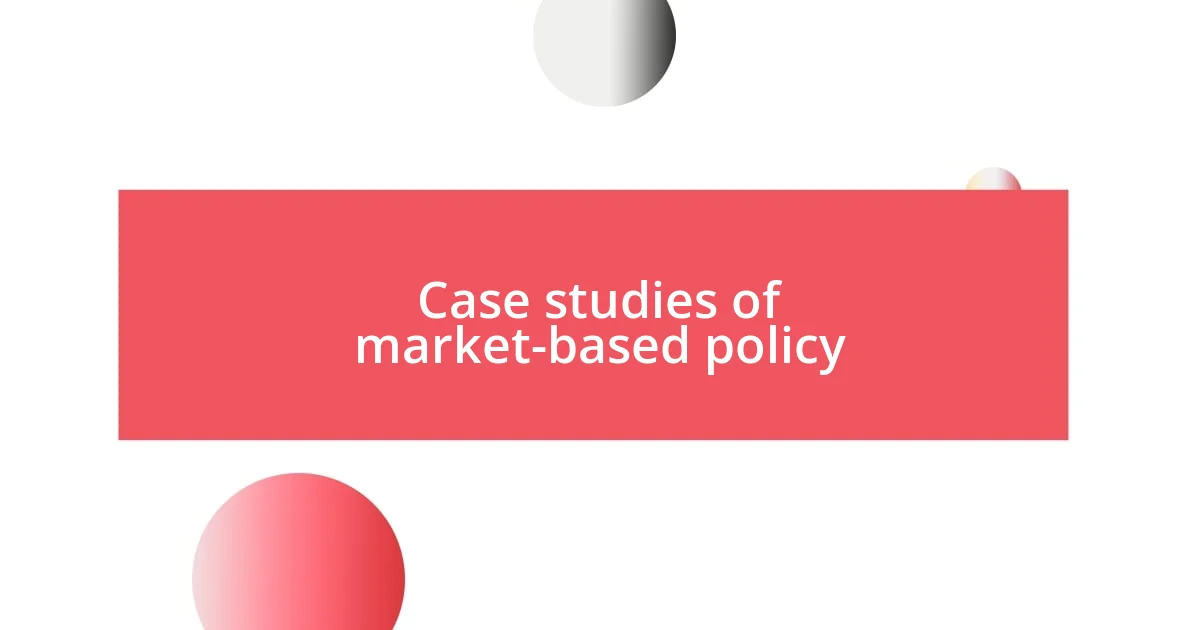Key takeaways:
- Market-based regulation leverages incentives and competition to drive innovation and align profit motives with environmental goals, exemplified by cap-and-trade systems.
- While offering benefits like adaptability and consumer empowerment, market-based approaches face challenges such as price volatility, equity concerns, and unintended consequences.
- The future of market regulation will focus on leveraging technology for real-time adaptability, emphasizing sustainability, and ensuring equity through transparent and inclusive frameworks.

Understanding market-based regulation
Market-based regulation is all about harnessing the power of incentives and competition to achieve policy goals. I remember the first time I encountered a carbon trading system; the idea that companies could actually buy and sell their pollution allowances was both fascinating and complex. It struck me then how nuanced regulation could be when we allow market forces to drive reductions in emissions.
What fascinates me is how market-based regulation isn’t just about rules; it’s about creating an environment where businesses are motivated to innovate. Have you ever noticed how companies often rush to develop greener technologies when they stand to gain economically? That’s the beauty of this approach—the market encourages creativity while also addressing pressing social issues.
As someone who has followed these systems closely, I can tell you that they often lead to unexpected outcomes. Take cap-and-trade systems, for instance; while the intention is to lower emissions, they can also lead to price fluctuations that impact the economy. Isn’t it intriguing how much the success of these regulations relies on finding the right balance between economic efficiency and environmental integrity?

Benefits of market-based approaches
Market-based approaches have a unique way of harnessing economic incentives to drive positive outcomes. From my experience, it’s impressive how such systems can align profit motives with social responsibility. For instance, when the Renewable Portfolio Standards were implemented, I observed firsthand how companies eagerly pursued clean energy solutions just for the financial benefits. This alignment of market interests with environmental goals can create a win-win scenario.
Another striking benefit of market-based regulation is its adaptability. It allows for a more dynamic response to evolving market conditions compared to traditional regulatory frameworks. I recall the rapid shift in electric vehicle adoption; when governments incentivized their purchase, we saw a surge of new models hitting the market. It really highlighted to me how market-based approaches can quickly pivot to capitalize on emerging technologies, driving widespread change more efficiently than rigid regulations.
Finally, a key advantage of market-based approaches is the empowerment of consumers. They can influence market behavior through their choices and preferences. I remember a time when organic products were niche. Now, due to consumer demand, it seems like every grocery store has an organic section. This consumer empowerment showcases how public interest can shape industry standards, leading to more sustainable practices across the board.
| Benefit | Description |
|---|---|
| Alignment of Interests | Market forces incentivize businesses to adopt greener practices for profit. |
| Adaptability | Systems can quickly adjust to changing market conditions and technologies. |
| Consumer Empowerment | Consumers drive demand, influencing companies to adopt sustainable practices. |

Challenges of market-based regulation
Market-based regulation might sound like a fantastic way to achieve policy goals, but it’s not without its hurdles. One challenge I often think about is the tragic potential for unintended consequences. For example, I remember hearing stories from farmers who participated in a water trading program intended to promote efficient water use. Instead, it led to some land being purposely left dry, which affected local ecosystems and communities. It’s eye-opening how a well-meaning approach can sometimes miss the mark and create more problems.
Here are a few challenges that market-based regulation often faces:
- Price Volatility: Markets can be unpredictable, leading to sudden shifts in costs that businesses may struggle to manage.
- Equity Concerns: Inequities can emerge, where larger corporations manipulate systems to their advantage, leaving smaller players at a disadvantage.
- Information Gaps: Not all participants have equal access to essential information, which can distort competition and lead to exploitation.
- Administrative Complexity: The design and implementation of these systems can be complicated, often requiring significant oversight and resources to ensure proper functioning.
- Marketplace Limitations: Sometimes, the market fails to account for all environmental costs, which can result in insufficient progress towards sustainability goals.
While I’ve seen great success with market-based regulations, it’s crucial to remain aware of these challenges. They can significantly shape the effectiveness and fairness of such systems.

Key principles of market mechanisms
When discussing market mechanisms, one of the key principles is the concept of supply and demand. I’ve often noticed how shifts in consumer preferences can really impact market dynamics. For example, when there was a growing interest in sustainable products, the demand surged, which in turn encouraged businesses to innovate. This interplay reminded me of a farmers’ market I visited, where local farmers quickly adapted their offerings based on what shoppers were looking for that week. Isn’t it fascinating how responsive markets can be?
Another important principle is price signals. I can’t stress enough how prices act as a form of communication within the market. When a cost goes up or down, it sends messages to suppliers and consumers alike. A few years back, I remember when renewable energy credits gained significant value. This price increase communicated to businesses that investing in green technologies was not just beneficial for the environment, but also for their bottom line. It highlights how markets can motivate entities to align their practices with broader environmental goals.
Lastly, the principle of competition cannot be overlooked. From my observations, healthy competition drives innovation and efficiency. During the early stages of the tech boom, I watched startups emerge, each vying for a unique selling point. This competition fueled advancements, like the rapid development of smartphone technology. It leads me to wonder, how might increased competition in sustainable practices push industries to evolve even further? This principle of competition illustrates that when multiple players are involved, the innovation potential expands dramatically, ultimately benefiting society as a whole.

Case studies of market-based policy
One fascinating case study of market-based policy comes from California’s cap-and-trade system, which I’ve followed closely. This initiative aimed to reduce greenhouse gas emissions by setting a regional limit on emissions and allowing companies to buy and trade permits. I recall attending a seminar where experts shared stories of how some innovative firms found ways to lower their emissions efficiently, reaping financial benefits while contributing to environmental goals. It’s inspiring to see how these market mechanisms can spur creativity and involvement among businesses striving to do better.
Another compelling example is the European Union Emissions Trading System (EU ETS). I’ve seen firsthand how European industries reacted to the carbon market’s price fluctuations. Some companies adapted remarkably well, investing in cleaner technologies to stay competitive. Others, unfortunately, struggled under the pressure, which raised questions for me about how effectively these policies can promote equity. If larger firms are better equipped to navigate such changes, what happens to those that lack resources? It’s a stark reminder that while markets can drive progress, they can also create disparities.
Lastly, the success of water markets in Australia is something I’ve often pondered over. During a trip, I met a farmer who shared with me the transformative impact of trading water rights. His operation became more sustainable, and he could adapt to climatic changes. This made me wonder—could similar approaches in other regions yield breakthrough outcomes for resource management? It’s remarkable how market-driven policies can provide solutions, especially in areas facing resource scarcity, but they also remind us to be aware of the broader implications for every community involved.

Future trends in market regulation
The future of market regulation seems poised for some significant shifts, particularly as technology continues to evolve. I’ve noticed that as data analytics become more sophisticated, regulators might leverage real-time insights to monitor and adapt policies continuously. This adaptability can empower regulators to address emerging issues like market monopolies or tech-driven inequalities more effectively. How does that shift the landscape of accountability, I wonder?
Additionally, the rise of decentralized finance (DeFi) is something that has me both excited and apprehensive. When I first learned about blockchain technology, I couldn’t help but think about its potential to democratize financial systems. If more people access financial services through decentralized platforms, will traditional regulators need to rethink their strategies entirely? This could lead to a more inclusive financial ecosystem, but I can’t shake the feeling that it might also invite new uncertainties.
Finally, I believe there’s going to be a growing emphasis on sustainability in market regulation. As environmental concerns take center stage in global conversations, regulations may evolve to prioritize eco-friendly practices. I remember when I first attended a sustainability conference and heard industry leaders commit to carbon-neutral goals. It struck me how vital it is for regulators to create frameworks that not only encourage such commitments but also hold businesses accountable. Will we witness regulations that incentivize companies to innovate further toward sustainability? Only time will tell, but the roadmap certainly looks promising.

Practical implications for policymakers
Policymakers need to approach market-based regulation with a clear understanding of its practical implications. I’ve seen how the effectiveness of these policies can vary based on the context and the stakeholders involved. For instance, during a recent discussion with fellow officials about water rights, it struck me how essential it is to create an equitable framework that ensures all stakeholders—especially small farmers—can participate and benefit from market mechanisms.
One critical aspect I’ve encountered is the importance of transparency in market-based policies. I recall speaking with a local community leader who expressed concern over the perceived complexity of trading systems. Her insight made me realize that if the rules aren’t clearly communicated, public trust can diminish, leading to resistance against necessary regulations. How can we expect sustainable practices to take root if the very framework seems opaque and inaccessible?
Additionally, it’s vital for policymakers to conduct thorough impact assessments before implementing market regulations. In a workshop I attended, a panelist shared how a misjudged cap-and-trade policy led to unintended consequences for smaller businesses in their jurisdiction. That made me ponder—are we truly considering the ripple effects of well-intended policies? Taking a step back to evaluate potential outcomes can foster a more inclusive approach that helps mitigate risks and build resilience in our economic systems.












